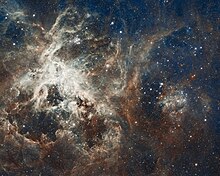فائل:30 Doradus, Tarantula Nebula.jpg

اس نمائش کا حجم: 749 × 599 پکسلز۔ دیگر تصمیمات: 300 × 240 پکسلز | 600 × 480 پکسلز | 960 × 768 پکسلز | 1,280 × 1,024 پکسلز | 2,560 × 2,048 پکسلز | 20,323 × 16,259 پکسلز۔
اصل فائل (20,323 × 16,259 پکسل، فائل کا حجم: 99.35 MB، MIME قسم: image/jpeg)
فائل کا تاریخچہ
کسی خاص وقت یا تاریخ میں یہ فائل کیسی نظر آتی تھی، اسے دیکھنے کے لیے اس وقت/تاریخ پر کلک کریں۔
| تاریخ/وقت | تھمب نیل | ابعاد | صارف | تبصرہ | |
|---|---|---|---|---|---|
| رائج الوقت | 18:35، 8 جولائی 2012ء |  | 20,323 × 16,259 (99.35 MB) | Prof. Professorson | Higher resolution, converted from http://spacetelescope.org/static/archives/images/original/heic1206a.tif. |
| 12:13، 19 اپریل 2012ء |  | 2,340 × 1,847 (2.52 MB) | Dipankan001 |
روابط
درج ذیل صفحہ اس فائل کو استعمال کر رہا ہے:
فائل کا عالمی استعمال
مندرجہ ذیل ویکیوں میں یہ فائل زیر استعمال ہے:
- af.wikipedia.org پر استعمال
- ar.wikipedia.org پر استعمال
- be-tarask.wikipedia.org پر استعمال
- bn.wikipedia.org پر استعمال
- crh.wikipedia.org پر استعمال
- cs.wikipedia.org پر استعمال
- cv.wikipedia.org پر استعمال
- de.wikipedia.org پر استعمال
- en.wikipedia.org پر استعمال
- Starburst region
- Wikipedia:WikiProject Astronomy/Recognized content
- Wikipedia:Featured pictures/Space/Looking out
- Wikipedia:Teahouse/Guests
- Wikipedia:Teahouse/Guest profile summary
- Wikipedia:Teahouse/Guest profile summary/Avatars
- Wikipedia:Teahouse/Guests/Left column
- Wikipedia:Teahouse/Guests/Right column
- User:The Determinator/Userpage/Top/Image
- Wikipedia:WikiProject Astronomy/Recognized astronomy content
- Wikipedia:Teahouse/Guest book/Archive 6
- Wikipedia:Teahouse/Guest/Featured/21
- Wikipedia:Teahouse/Guest/Featured/22
- Wikipedia:Teahouse/Guest book/Archive 12
- Wikipedia:Teahouse/Guest book/Archive 13
- Wikipedia:Teahouse/Guest book/Archive 14
- Wikipedia:Teahouse/Guest book/Archive 15
- Wikipedia:Teahouse/Guest book/Archive 16
- Wikipedia:Teahouse/Guest book/Archive 17
- Wikipedia:Teahouse/Guest book/Archive 18
- Wikipedia:Teahouse/Guest book/Archive 19
- Wikipedia:Teahouse/Guest book/Archive 20
- Wikipedia:Teahouse/Guest book/Archive 21
- Wikipedia:Teahouse/Guest book/Archive 22
- Wikipedia:Teahouse/Guest book/Archive 23
- Wikipedia:Teahouse/Guest book/Archive 26
- Wikipedia:Teahouse/Guest book/Archive 28
- Wikipedia:Teahouse/Guest book/Archive 29
- Wikipedia:Teahouse/Guest book/Archive 30
- Wikipedia:Teahouse/Guest book/Archive 31
- Wikipedia:Teahouse/Guest book/Archive 34
- Wikipedia:Teahouse/Guest book/Archive 35
- Wikipedia:Teahouse/Guest book/Archive 36
- Wikipedia:Teahouse/Guest book/Archive 37
- Wikipedia:Teahouse/Guest book/Archive 39
- Wikipedia:Teahouse/Guest book/Archive 40
- User:LucasTichawa
- Wikipedia:Teahouse/Guest book/Archive 42
- Wikipedia:Teahouse/Guest book/Archive 43
- Wikipedia:Teahouse/Guest book/Archive 44
- Wikipedia:Teahouse/Guest book/Archive 45
اس فائل کا مزید عالمی استعمال دیکھیے۔


